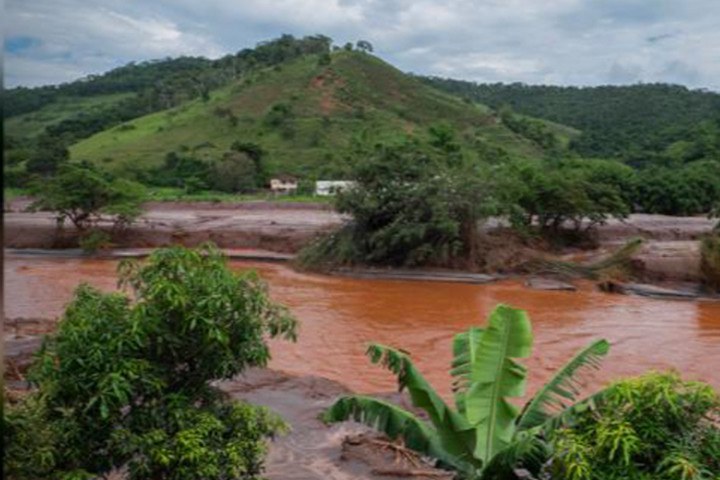Posted: April 19, 2021
Exposure of dairy cows to heavy metals through drinking water worsens the antibiotic-resistant-pathogen crisis.

The Mariana Dam disaster in 2015 released more than 11 billion gallons of iron ore waste. The huge wave of toxic mud flowed into the Doce River (shown here) basin surrounding Mariana City in Minas Gerais, a state in southeast Brazil. Photo: Erika Ganda
Dairy cows that have been exposed for a few years to drinking water contaminated with heavy metals carry more pathogens loaded with antimicrobial resistance genes able to tolerate and survive various antibiotics.
That's the finding of a team of researchers that conducted a study of two dairy herds in Brazil four years after a dam holding mining waste ruptured, and it spotlights a threat to human health, the researchers contend.
The study is the first to show that long-term persistence of heavy metals in the environment may trigger genetic changes and interfere with the microorganism communities that colonize dairy cows, according to researcher Erika Ganda, assistant professor of food animal microbiomes.
"Our findings are important because if bacterial antimicrobial resistance is transferred via the food chain by milk or meat consumption, it would have substantial implications for human health," she said. "What we saw is, when heavy metal contamination is in the environment, there is potential for an increase of so-called 'superbugs.'"
A declaration from the World Health Organization supports Ganda's assertion, saying that resistance to antimicrobials is one of the top 10 global public health threats facing humanity. Antimicrobial resistance occurs when bacteria, viruses, fungi, and parasites change over time and no longer respond to medicines, making infections harder to treat and increasing the risk of disease spread, severe illness, and death.
A South American environmental calamity triggered the research. Known as the Mariana Dam disaster, in 2015 the Fundao Tailings Dam suffered a catastrophic failure and released more than 11 billion gallons of iron ore waste. The huge wave of toxic mud flowed into the Doce River basin surrounding Mariana City in Minas Gerais, a state in southeast Brazil.
Following this catastrophe, the team analyzed the consequences of long-term exposure to contaminated drinking water on dairy cattle.
To reach their conclusions, the researchers identified bacterial antimicrobial resistance genes in the feces, rumen fluid, and nasal passages of 16 dairy cattle in the area contaminated by the iron ore waste four years after the environmental disaster. Researchers compared samples taken from those animals to analogous samples from 16 dairy cattle on an unaffected farm about 220 miles away.
They found that the relative abundance and prevalence of bacterial antimicrobial resistance genes were higher in cattle at the farm affected by the heavy metals than in cattle at the noncontaminated farm.
The data, published in Frontiers of Microbiology, suggest that exposure to heavy metal contamination results in the selection of bacteria that have resistance genes to heavy metals, biocides, and several drugs.
--Jeff Mulhollem
Features
Breaking the Silence on Farm Stress
Farming has always been a demanding profession, but today's farmers face unprecedented pressures that can severely impact their mental health.
Biting Back
Research Targets Vector-Borne Diseases to Save Lives
Leading Forward
Ott brings deep connection to role of dean.


